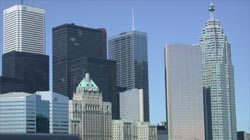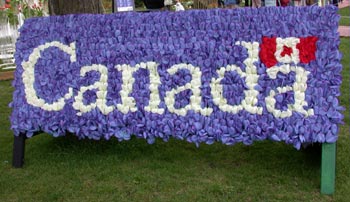
ABOUT CANADA
Geography
Canada consists of 10 provinces and three territories in five main regions:
the Atlantic region, Central Canada, the Prairies, the West Coast and the North.
The culture and population are different in each region.
The Atlantic region consists of the provinces of Nova Scotia, New Brunswick,
Prince Edward Island, and Newfoundland and Labrador. Activities such as fishing,
farming, forestry, tourism and mining are important to the Atlantic economy.
Central Canada consists of the provinces of Ontario and Quebec. This is the most
populated region of the country. Together, Ontario and Quebec produce more than
three-quarters of all Canadian manufactured goods.
The Prairies include the provinces of Manitoba, Saskatchewan and Alberta.
Much of the land is flat and fertile, excellent for farming and rich in energy
resources. In western Alberta, the Prairies end and the Rocky Mountains begin.
The Canadian Rockies include some of the largest peaks in North America.
On the West Coast, the province of British Columbia is famous for its mountain
ranges and forests. Natural resources such as lumber and fish are important to
the economy. Fruit farming is also a major industry, as is tourism.
The North consists of Canada's three territories: Yukon, the Northwest Territories
and Nunavut. Together, they make up over one-third of Canada's land mass. Northern
resources include oil, natural gas, gold, lead and zinc.
Distances
Distances in Canada are measured in kilometres. Canada is over 7,000 kilometres
from east to west. You would need seven days to drive from Halifax, Nova Scotia,
to Vancouver, British Columbia. By airplane, the same trip would take about seven hours.
Population
Canada has about 31 million people. More than 80 percent of all the people in
Canada live in towns and cities within 250 kilometres of the United States border.
Ottawa is Canada's capital city, with a population of nearly one million.
It is located in the province of Ontario. Canada's largest cities are Toronto,
Ontario (4.4 million people); Montreal, Quebec (3.4 million); and Vancouver,
British Columbia (1.9 million).
Map of Canada

| Region |
Province/Territory |
Capital |
| Atlantic Region |
Newfoundland and Labrador |
St. John's |
| Prince Edward Island |
Charlottetown |
| Nova Scotia |
Halifax |
| New Brunswick |
Fredericton |
| Central Canada |
Quebec |
Québec |
| Ontario |
Toronto |
| Prairie Provinces |
Manitoba |
Winnipeg |
| Saskatchewan |
Regina |
| Alberta |
Edmonton |
| West Coast |
British Columbia |
Victoria |
| North |
Nunavut |
Iqaluit |
| Northwest Territories |
Yellowknife |
| Yukon |
Whitehorse |
The Francophone population
French is the mother tongue of 6.6 million Canadians. Most Francophones live in Quebec,
but almost one million Francophones live in Canada's other provinces and territories.
About 76 percent of Francophones living outside Quebec live in Ontario and
New Brunswick. Manitoba, Alberta and British Columbia each have approximately 50,000
Francophones, while Nova Scotia has 35,000 and Saskatchewan has fewer than 20,000.
The areas with the smallest French-speaking populations are Prince Edward Island,
Newfoundland and Labrador, and the three territories.
 Economy
Economy
Canada has a diversified economy. Natural resources industries, such as forestry,
mining, oil and gas extraction, farming and fishing, are important sources of jobs
and export earnings. Canada is also a world leader in the fields of telecommunications,
biotechnology, aerospace technologies and pharmaceuticals. More and more jobs involve
work in service industries or in information technology. Along with the United States
and Mexico, Canada is a partner in the North American Free Trade Agreement.
Canada has a decimal system of currency. The Canadian dollar is the basic unit of
money. The most common paper bills are the $5, $10 and $20, but $50 and $100 bills
are also used. Canadian coins include the penny (one cent), nickel (five cents),
dime (10 cents), quarter (25 cents), loonie ($1) and toonie ($2).
History
Canada is a land of many cultures and many peoples. Aboriginal peoples have occupied
the territory now called Canada for several thousands of years. Everybody else, either
by birth or by descent, has been an immigrant - we have all come from somewhere else.
It has been said that Canada is a "nation of immigrants."
There are three main groups of Aboriginal peoples in Canada: the First Nations,
the Inuit and the Metis. There are more than 50 different languages spoken by Canada's
Aboriginal peoples, most of which are spoken only in Canada. In fact, the name "Canada"
may have come from the word "Kanata," which means a settlement in the language of the
Huron-Iroquois First Nations peoples.
As a country, Canada came into being on July 1, 1867. This event is known as
"Confederation". Before 1867, the French arrived first, then the British.
Each brought their own language, system of government, laws and culture. In 1763,
after a long war between the British and the French, all of Canada came under British
rule and was known as "British North America".
In the late 18th and into the 19th century, during and after the time of the
American Revolution, many African-Americans and United Empire Loyalists fled the
United States for Canada, where British ties remained and slavery had been abolished.
During the mid- to late 19th and early 20th century, waves of immigrants arrived from
Europe, attracted by the opportunity of a new and better life in Canada. Some settled
in towns and cities; others worked in factories, mines and lumber camps. Many were
farmers who turned the Prairie region into wheat fields. Asian immigrants from China,
Japan and India settled mainly in the western provinces during this time. Many
immigrants helped build Canada's national railways, which joined the east and west
coasts and opened up the interior for settlement.
After both world wars, thousands of Europeans came to Canada as immigrants and
refugees and helped build Canada's post-war economy. Canada's experience during and
after the Second World War raised awareness of the needs of refugees and the desire
of families to be together.
Over the last 50 years, people from all over the globe have sought a better life or
have sought refuge in Canada, fleeing civil wars, political unrest and natural
disasters.
Canada still needs the skills, talents and enthusiasm of newcomers to build our
country, together with those who have come before them. All of this has been
reflected in Canada's immigration and refugee policies. Today, Canada is home to
immigrants from more than 240 countries. Most newcomers decide to become citizens of
Canada, after they are settled and have met the requirements of Canadian citizenship.
 Government
Government
Canada is a federation, with a parliamentary system of government. Being a federation
means that powers and responsibilities are divided between the federal government and
the 10 provincial governments. Canada also has three territorial jurisdictions.
Canada has three levels of government: federal, provincial and municipal (cities and
towns). These governments are elected by the citizens of Canada.
Bilingualism
Under the Official Languages Act, Canada is an officially bilingual country.
This means that Canadians have the right to get federal government services in English
or French, no matter what part of Canada they are living in.
New Brunswick is the only province that is officially bilingual. New Brunswick
residents receive services in both official languages from all of their provincial
government departments and agencies.
In Quebec, French is the official language and in most cases, provincial and municipal
services are provided in French.
In the other provinces and territories, English is the official language, and the
availability of provincial services in both official languages varies.
At the municipal level, the availability of services in both official languages
varies greatly.
Multiculturalism
Canada is populated by people who have come from every part of the world.
Through the Canadian Multiculturalism Act, the government encourages Canadians to take
pride in their language, religion and heritage and to keep their customs and traditions,
as long as they don't break Canadian laws.

| 








